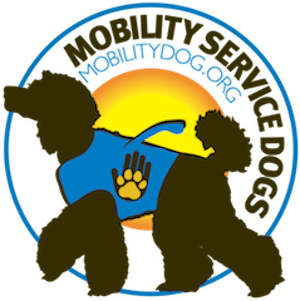Service Dog Teams: What is their Purpose?
Since 1990, service dogs are legally recognized by the Americans with Disabilities Act (ADA) as dogs trained to provide assistance to disabled people. For a disabled person, the service dog represents the priceless ability to more be independent in both private and public.
According to the CDC, 61 million adults in America are living with a disability today.
In addition, the U.S. Census Bureau revealed over 3 million children under the age of 18 are also challenged with a disability (4.3% of that population) as of 2019.
From these statistics, it’s easy to see how great the need is for service dog teams in just the United States alone!
What is a Service Dog Team?
An ADA-approved service dog team includes a specifically trained dog to perform specific tasks directly related to the physical or mental disability of the human they are teamed with (known as handlers) and their specific medical needs.
Learn about the different types of service dogs here.
This dog and human team are viewed as a working partnership allowing the disabled person to regain their independence at home and in public spaces. This designation by the ADA identifies the dog as more than a pet and as such is protected under federal law as a service dog.
Facts About Service Dogs:
According to the AKC, the average training of a service dog can cost around or above $25,000!
As many as 50-70% of dogs in training do not complete their training due to issues with temperament, trainability, health, physical attributes or the history of the canine’s parents.
Service dogs must be handler-focused, unfazed by distractions and highly dependable to perform the specific tasks for which they were trained.
Service Dog Teams: What is Their Purpose?
As we’ve touched on above, the service dog provides day-to-day support with specific tasks for their disabled handler offering a better quality of life and independence.
Service dogs are trained as:
Seeing Eye Dogs.
Signal or Hearing Dogs.
Mobility or Brace dogs.
Medical Alert Dogs; and
Psychiatric Assistance Dogs.
Emotional support animals (ESAs), comfort or therapy dogs and courthouse dogs are not legally recognized as service dogs under the ADA and as such, are not afforded the same legal protections and accesses.
The service dog team is legally allowed full access to all public places and cannot be refused entry or services or separated from their legal service dog. Even businesses or housing with a “no pet” policy must allow the service dog team full and free access as they would with someone who is not disabled.
Under the ADA, those with physical or mental impairments or disabilities (or a combination of) can legally qualify for a trained service dog. These impairments are defined by the ADA as follows but are not limited to the conditions listed below.
Courtesy: MobilityDog.org
Physical Impairment Definition
Any physiological disorder or condition, cosmetic disfigurement, or anatomical loss affecting one or more of the following body systems: neurological, musculoskeletal, special sense organs, respiratory (including speech organs), cardiovascular, reproductive, digestive, genitourinary, hemic and lymphatic, skin, and endocrine.
Mental Impairment Definition
Any mental or psychological disorder, such as mental retardation, organic brain syndrome, emotional or mental illness, and specific learning disabilities.







